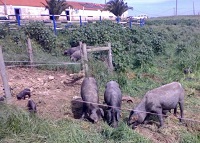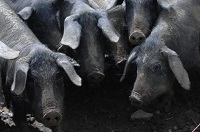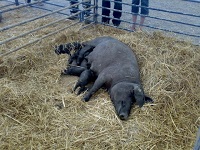The Porco Alentejano
... is a unique species with a charakter of its own, which represents an enormously significant contribiution to the world genetic heritage. It is the last remaining free grazing pig in Europe. An exceeding animal that is perfectly adapted to its natural habitat.
The Porco Alentejano is distinguished bu its long, thin and sturdy legs, a pointy snout, and relatively hairless, dark skin. A species resulting from millions of years of adaptive effort and centuries perseverant selection in order to get the most out of the natural recources available in its natural environment. The black pasture pigs are an old race, which were already in former times very gladly held because of their robustness and high meat quality. Because they grow more slowly and fewer meats sets than animals industrially held is more tenderly, juicier their meat and distinguished a good flavour.
The Porco Alentejano developed a genetic ability to store large fatty deposits that become part of its muscle mass and create a characteristaric white streaks that give the ham its incomperable marbleised texure and aroma.
Following an initial period of on its mother´s milk, the pic embarks on the slow preperation phase. Our black pasture pigs nourish themselves to the large part of what they find in the open land. That pleases the pigs and nature, because when rooting the animals tear the closed grass scar up and create so again and again new habitat for rare animal and plant types.
The animals feeds on gras, seeds and grain (barley, wheat and oats), usually from own cultivation. With this diet, it reaches a weight of netween 80 and 115 kg within a year, which is the optimum weight to reap the maximum benefit from the recources from the Alentejo during the fattening period. Than the pic incorporates acorn to its diet and can at up to 10 kg a day. Therefore, during this stage each animal needs between 1.5 and 2 hectaresto cover its dietary requirements. The constant exercice it gets while searching for food its a determining in the quatilty of the meat.
Pigs feel from nature best, if they can move outside freely.
Then they are healthiest and have very tasty meat. The Iberian Pig is also called ".. an olive tree on four legs…" since the intercalated fat due to it's high content of oleic acid is rich in unsaturated fatty acids and acts cardio protectively.
Information:
This page shows basic information. There is no guarantee for the correctness and completeness of the given facts. The page is regularly updated.









